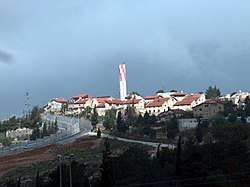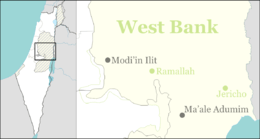Beit Horon
Beit Horon (Hebrew: בֵּית חוֹרוֹן) is a communal Israeli settlement in the West Bank. Bordering Route 443 between Modi'in and Jerusalem, the biblical pass of Beit Horon (Joshua 10:10), after which it is named,[2] it falls under the jurisdiction of Mateh Binyamin Regional Council. In 2018 it had a population of 1,362.
Beit Horon | |
|---|---|
 | |
 Beit Horon | |
| Coordinates: 31°52′36.12″N 35°7′43.32″E | |
| Country | Israel |
| District | Judea and Samaria Area |
| Council | Mateh Binyamin |
| Region | West Bank |
| Affiliation | Amana |
| Founded | 1977 |
| Population (2018)[1] | 1,362 |
The international community considers Israeli settlements in the West Bank illegal under international law, but the Israeli government disputes this.[3]
History
Beit Horon was established on 1 December 1977.[4]
According to ARIJ, Israel confiscated land from several surrounding Palestinian villages in order to construct Beit Horon:
- 1036 dunams from Beitunia, for Beit Horon and Giv'at Ze'ev,[5]
- 863 dunams from Beit Ur al-Fauqa,[6]
- 67 dunams from At-Tira.[7]
Beit Horon is a joint Secular and Orthodox community.[8] A religious elementary school located in Beit Horon serves local children as well as those from surrounding villages. There are also three nurseries and kindergarten, two synagogues, a kollel, a mikvah for women and men, and a library.[9]
References
- "Population in the Localities 2018" (XLS). Israel Central Bureau of Statistics. 25 August 2019. Retrieved 26 August 2019.
- Carta's Official Guide to Israel and Complete Gazetteer to all Sites in the Holy Land. (3rd edition 1993) Jerusalem, Carta, p.112, ISBN 965-220-186-3 (English)
Bitan, Hanna: 1948-1998: Fifty Years of 'Hityashvut': Atlas of Names of Settlements in Israel, Jerusalem 1999, Carta, p.10, ISBN 965-220-423-4 (Hebrew) - "The Geneva Convention". BBC News. 10 December 2009. Retrieved 27 November 2010.
- "Israelis, Palestinians Share Fears As Talks Likely Delayed". Orlando Sentinel. July 23, 1995. Retrieved August 22, 2012.
- Beituniya Town Profile, ARIJ, pp. 17-18
- Beit ‘Ur al Fauqa Village Profile, ARIJ, p. 16
- At Tira Village Profile, ARIJ, p. 16
- “BEIT HORON.” תנועת ההתיישבות אמנה, בית חורון, http://www.amana.co.il/?CategoryID=100&ArticleID=169.
- Beit Horon Archived July 27, 2011, at the Wayback Machine Amana